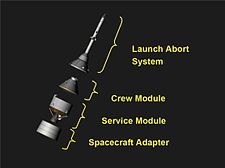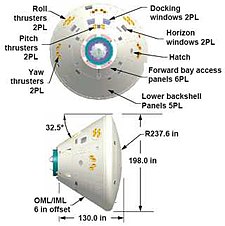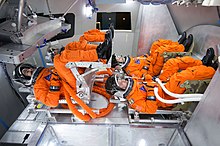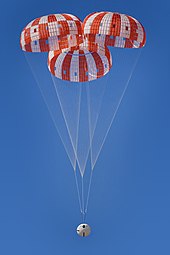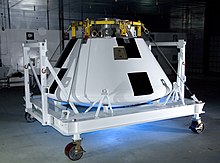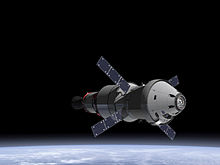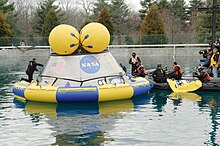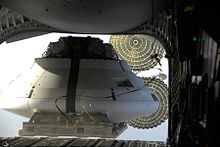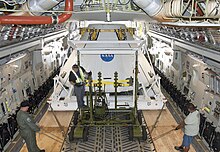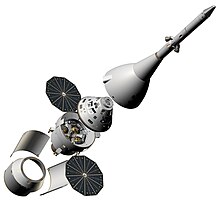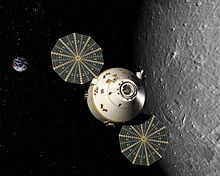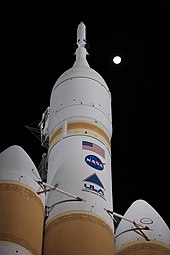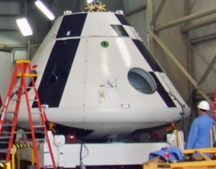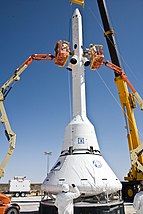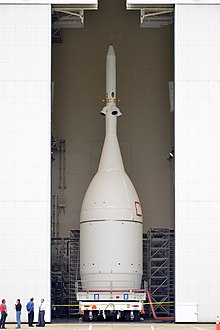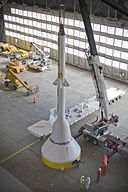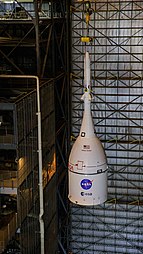오리온 (우주선)
Orion (spacecraft) | |
| 제조원 | |
|---|---|
| 교환입니다. | NASA[1] |
| 적용들 | LEO를 넘어선[2] 승무원 탐사 |
| 사양 | |
| 우주선 종류 | 크루드 |
| 발사 질량 |
|
| 건조 질량 |
|
| 페이로드 용량 | 220파운드(100kg) 리턴 페이로드 |
| 승무원 정원 | 2[4] ~ 6 |
| 용량 |
|
| 힘 | 태양의 |
| 정권 | 달 궤도, 달 궤도 |
| 설계 수명 | 21.1 일[3] |
| 치수 | |
| 길이 | 10피트 10인치 (3.30m) |
| 직경 | 16 피트 6 인치 (5.03 m) |
| 생산. | |
| 상황 | Artemis 1에서 실행 |
| 주문시 | 6~12(+3) 2019년 이전에 주문 완료 |
| 지었다. | 4 |
| 개시. | 2 |
| 첫 출시 | 2014년 12월 5일 |
| 관련 우주선 | |
| 유래 | |
 | |
오리온(Orion Multi-Purpose Crew Vehicle, 공식 명칭: Orion MPCV)은 NASA의 Artemis 프로그램에 사용되는 부분적으로 재사용 가능한 승무원 우주선이다.이 우주선은 록히드 마틴이 설계한 크루 모듈(CM) 우주 캡슐과 에어버스 디펜스 앤 스페이스가 제작한 유럽 서비스 모듈(ESM)로 구성되어 있다.지구 저궤도 너머에서 6명의 승무원을 지원할 수 있는 오리온은 도킹 해제 후 최대 21일, 최대 6개월까지 버틸 수 있다.그것은 태양 전지판, 자동 도킹 시스템, 그리고 보잉 787 드림라이너에 사용된 것을 본뜬 유리 조종석 인터페이스를 갖추고 있다.AJ10 엔진 하나가 우주선의 1차 추진력을 제공하는 반면, 8개의 R-4D-11 엔진과 에어버스가 개발한 6개의 맞춤형 반응 제어 시스템 엔진이 우주선의 2차 추진력을 제공합니다.다른 발사체들과 호환되지만, 오리온은 주로 우주발사시스템(SLS) 로켓 위에 타워형 발사 탈출 시스템을 탑재하여 발사하는 것을 목적으로 한다.
오리온은 원래 2000년대 초 록히드 마틴에 의해 NASA의 Constellation 프로그램에 사용될 승무원 탐사선(CEV)의 제안으로 고안되었다.록히드 마틴의 제안은 노스롭 그루먼의 경쟁 제안을 물리치고 2006년 NASA에 의해 CEV로 선정되었습니다.원래 새로운 "오리온 메인 엔진"과 한 쌍의 원형 태양 전지판을 갖춘 서비스 모듈로 디자인된 이 우주선은 아레스 I 로켓 위에 발사될 예정이었다.2010년 콘스텔레이션 프로그램이 취소된 후, 오리온은 NASA의 화성 여행 계획(나사: Journey to Mars initiative, 나중에 Moon to Mars)에 사용하기 위해 크게 재설계되었다.SLS는 아레스 I을 오리온의 1차 발사체로 대체했고 서비스 모듈은 유럽우주국의 자동이송체에 기반한 디자인으로 대체됐다.오리온 CM의 개발 버전은 탐사 비행 테스트-1에서 2014년에 발사되었고, 최소 4개의 테스트 제품이 생산되었습니다.오리온은 주로 콜로라도주 리틀턴에 있는 록히드 마틴 우주 시스템에 의해 설계되었다.2022년 현재[update], 3개의 비행 가능한 오리온 우주선이 제작 중이며, 한 개는 완성되었고 한 개는 추가로 [a]주문되어 나사의 아르테미스 프로그램에 사용되었습니다.
첫 번째 완성된 유닛 CM-002는 2022년 11월 16일 Artemis [9][10][11]1에 발사되었다.
우주선 설명
오리온은 우주인을 달에 처음 데려갔던 아폴로 우주왕복선(CSM)과 같은 기본 구성을 사용하지만, 지름이 증가했고, 열 보호 시스템이 업데이트되었으며, 다른 현대 기술들이 적용되었다.그것은 최장 21일의 현역 승무원 시간과 6개월의 정지 상태의 우주선 [12]수명으로 장기간의 심우주 임무를 지원할 수 있을 것이다.대기 시간 동안 승무원의 생명 지원은 제안된 딥 스페이스 해비타트와 같은 다른 모듈에 의해 제공될 것이다.우주선의 생명 유지 장치, 추진 장치, 열 보호 장치, 그리고 항전 장치들은 새로운 기술이 사용 [13]가능해짐에 따라 업그레이드될 수 있습니다.
오리온 우주선은 승무원과 서비스 모듈, 우주선 어댑터, 비상 발사 중지 시스템을 모두 포함하고 있다.오리온호의 승무원 모듈은 아폴로호보다 더 크고 단기 또는 장기간의 임무를 위해 더 많은 승무원들을 지원할 수 있다.유럽 서비스 모듈은 우주선을 추진 및 작동시키고 우주 비행사들을 위한 산소와 물을 저장하기 때문에 오리온은 연료 전지보다는 태양 에너지에 의존하기 때문에 더 긴 임무를 수행할 수 있다.
승무원 모듈(CM)
오리온 선원모듈(CM)은 선원들에게 서식지를 제공하고 소모품 및 연구 장비를 보관하며 선원 [13][14][15]이송을 위한 도킹 포트를 포함하는 재사용 가능한 운송 캡슐이다.승무원 모듈은 각 임무를 마치고 지구로 귀환하는 유일한 부품으로 57.5°의 좌충우돌 모양이며, 직경 5.02m(16피트 6인치), 길이 [16]3.3m(10피트 10인치)로 질량은 약 8.5톤(19,000파운드)이다.그것은 뉴올리언스에 [17][18][19][20]있는 Michoud 조립 시설에서 록히드 마틴 사에 의해 제조되었다.그것은 아폴로 캡슐보다 부피가 50% 더 클 것이고 4명에서 6명의 [21]우주인을 태울 것이다.광범위한 연구 끝에 NASA는 오리온 선원 모듈을 렌트하는 동안 발생하는 열을 보호하기 위해 Avcoat 애블레이터 시스템을 선택했습니다.섬유유리와 페놀 수지로 만들어진 벌집안에 수지를 넣은 실리카 섬유로 구성된 에이브코트는 이전에는 아폴로 우주왕복선 궤도선에 사용되었던 초기 [22]비행용이었다.
오리온의 CM은 다음과 같은 첨단 기술을 사용합니다.
- 보잉 787에서 파생된 [23]글라스 콕핏 디지털 제어 시스템.
- Progress, Automated Transfer Vehicle, Dragon 2와 같은 "Autodock" 기능으로, 비상 시 승무원이 인수할 수 있습니다.이전의 미국 우주선은 드래곤 2를 제외하고 모두 승무원들에 의해 도킹되었다.
- 우주왕복선에 사용되는 미니어처 캠핑식 화장실과 남녀 공용 '구제관'을 갖춘 폐기물 관리 시설 개선.
- 해수면(101.3kPa 또는 14.69psi) 또는 감소(55.2~70.3kPa 또는 8.01~10.20psi) 압력에서 질소/산소(N
2/O
2) 혼합 대기.
CM은 알루미늄-리튬 합금으로 제작됩니다.재사용 가능한 회수용 낙하산은 아폴로 우주선과 우주왕복선 고체 로켓 부스터에 사용된 낙하산을 기반으로 하며 노멕스 천으로 제작될 것이다.수상 착륙은 [24][25]오리온 우주선의 유일한 회복 수단이 될 것이다.
오리온이 다른 우주선과 짝짓기를 할 수 있도록 하기 위해, 그것은 NASA 도킹 시스템을 장착할 것이다.이 우주선은 "부스트 프로텍션 커버" (섬유 유리로 만들어진)와 함께 첫 비행 동안 공기역학과 충격 스트레스로부터 오리온 CM을 보호하기 위해 발사 중지 시스템 (LAS)을 사용할 것이다.오르막 2+1.5분오리온은 [26]우주왕복선보다 상승 및 재진입 시 10배 더 안전하도록 설계되었다.CM은 리퍼비시 및 재사용이 가능하도록 설계되어 있습니다.게다가, 오리온의 모든 부품들은 가능한 모듈식으로 설계되어 있어, 2014년 첫 시험 비행에서 2030년대 화성 항해를 앞두고, 새로운 기술을 이용할 [13]수 있게 되면서 우주선이 업그레이드 될 수 있다.
2019년부터 우주선 대기 모니터는 오리온 [27]CM에 사용될 예정이다.
유럽 서비스 모듈(ESM)
2011년 5월, ESA 사무총장은 자동 전송 차량(ATV)[28]의 후속 기종을 개발하기 위한 NASA와의 협력 가능성을 발표했습니다.2012년 6월 21일, Airbus Defense and Space는 ATV와 콜럼버스 관련 작업을 통해 얻은 기술과 경험을 향후 임무에 사용할 수 있는 가능성을 평가하기 위해 각각 650만 유로 상당의 두 개의 별도 연구를 수상했다고 발표했다.첫 번째는 Orion [29]CM과 함께 사용되는 서비스 모듈의 구성 가능성에 대해 조사했습니다.두 번째는 다목적 궤도 [30]차량의 생산 가능성을 조사했다.
2012년 11월 21일,[31] ESA는 오리온용 ATV 유래 서비스 모듈을 개발하기로 결정했습니다.이 서비스 모듈은 [32]독일 브레멘의 Airbus Defense and Space에 의해 제조되고 있습니다.NASA는 2013년 1월 16일, ESA 서비스 모듈이 우주 발사 시스템의 [33]첫 번째 발사인 Artemis 1호에 탑승할 것이라고 발표했다.
유럽 서비스 모듈의 테스트는 2016년 2월 우주 전력 [34]시설에서 시작되었습니다.
2017년 2월 16일, Airbus와 유럽 우주국 사이에 최초의 승무원 오리온 비행선 Artemis [35]2에 사용할 두 번째 유럽 서비스 모듈의 생산을 위한 2억 유로 계약이 체결되었습니다.
2018년 10월 26일 Artemis 1의 첫 번째 유닛은 독일 [36]브레멘에 있는 Airbus Defense and Space 공장에서 완전히 조립되었습니다.
Launch Abort System(LAS)
발사 패드 또는 상승 중에 비상 정지 시스템(LAS)를 사용하여 발사 중지 시스템(LAS)를 사용하여 모터(LAS)를 탑재할 수 있다. 정상AM과[38] 분사 모터가 승무원 [39]캡슐에서 LAS를 분리합니다.2007년 7월 10일, LAS의 주요 계약자인 Orbital Sciences는 Alliant Techsystems(ATK)에 "역류"[40] 설계를 사용하는 "발사 중단 모터"를 설계, 개발, 생산, 테스트 및 납품하는 6,250만 달러의 하도급을 부여했습니다.2008년 7월 9일, 나사는 ATK가 오리온 [41]우주선의 발사 중단 모터를 시험하기 위해 유타주 프로몬토리의 한 시설에 수직 시험대를 건설했다고 발표했다.또 다른 오랜 우주 모터 계약자인 에어로젯은 LAS의 제트 모터 설계 및 개발 계약을 따냈다.2008년 9월 현재 Aerojet은 Orbital Sciences, Lockheed Martin 및 NASA와 함께 분사 모터의 두 번의 본격적인 시험 발사에 성공했습니다.이 모터는 발사 성공과 발사 [42]중단 후 LAS를 차량에서 분리하기 때문에 모든 비행에서 사용됩니다.
역사
오리온 MPCV는 2011년 [43]5월 24일 NASA에 의해 발표되었다.그 디자인은 2006년 록히드 [45]마틴과 NASA의 계약상이었던 취소된 콘스텔레이션 [44]프로그램의 승무원 탐사선에 바탕을 두고 있다.이 명령 모듈은 록히드 마틴이 미후드 조립 [18][19]시설에서 제작하고 있으며 오리온 서비스 모듈은 유럽우주국의 [33][46][32][36]자금으로 브레멘의 에어버스 디펜스 앤 스페이스가 제작하고 있다.MPCV의 첫 무인 시험 비행은 2014년 12월 5일 델타 IV 헤비 로켓 위에서 발사되어 태평양에 [47][48][49][50]있는 목표물에 착륙하기 전에 4시간 24분 동안 지속되었다.
2020년 11월 30일, NASA와 록히드 마틴이 오리온 우주선의 동력 데이터 장치 중 하나에서 고장을 발견했다고 보도되었지만, 나사는 나중에 이 문제가 아르테미스 1호의 발사 [51][52]날짜에 영향을 미칠 것으로 예상하지 않는다고 밝혔다.
자금조달 이력 및 계획
2006~2022 회계연도에 오리온 프로그램은 총 215억4700만 달러의 자금을 명목 달러로 지출했다.이는 미국항공우주국(NASA)의 뉴스타트 인플레이션 지수([53]New Start Inflation Index)를 사용한 2022년 262억9900만달러에 해당한다.
현 정부는 2023 회계연도에 오리온 프로그램에 13억3900만[54] 달러를 요구하고 있다.
| 회계연도 | 자금 지원, 명목 비용(백만 달러) | 2022년 자금 지원(백만 달러)[53] | 라인품명 |
|---|---|---|---|
| 2006 | 839.2 | 1,224.7 | CEV[55] |
| 2007 | 714.5 | 1,004.0 | CEV[56] |
| 2008 | 1,174.1 | 1,593.1 | CEV[57] |
| 2009 | 1,747.9 | 2,327.4 | CEV[57] |
| 2010 | 1,640 | 2,154.2 | CEV[57] |
| 2011 | 1,196.0 | 1,546.0 | MPCV[58] |
| 2012 | 1,200 | 1,534.9 | 오리온[59] MPCV |
| 2013 | 1,138 | 1,403.5 | 오리온[60] MPCV |
| 2014 | 1,197 | 1,479.3 | 오리온[61] 계획 |
| 2015 | 1,190.2 | 1,441.9 | 오리온[62] 계획 |
| 2016 | 1,270 | 1,520.2 | 오리온[63] 계획 |
| 2017 | 1,350.0 | 1,582.3 | 오리온자리[64] |
| 2018 | 1,350.0 | 1,543.1 | 오리온자리[65] |
| 2019 | 1,350.0 | 1,513.9 | 오리온자리[66] |
| 2020 | 1,406.7 | 1,543.3 | 오리온자리[67] |
| 2021 | 1,400.5 | 1,480.5 | 오리온자리[68] |
| 2022 | 1,406.7 | 1,406.7 | 오리온자리[69] |
| 2006–2022 | 합계 21,547달러 | 합계 26,299달러 |
이전 오리온 비용에서 제외된 항목은 제외됩니다.
- 대부분의 비용은 [70]"2021년 이후에 이 캡슐을 사용하고 개선할 계획에도 불구하고 추가 승무원 캡슐의 생산, 운영 또는 유지"에 소요됩니다. 생산 및 운영 계약은 2020 회계연도로[71] 넘어갑니다.
- 오리온 시험 비행에 ESA가[72] 제공하는 첫 번째 서비스 모듈 및 예비 부품의 비용(약 [73]10억 달러)
- 오리온과 그 발사기의 조립, 통합, 준비 및 발사 비용(현재 NASA 지상 운영 프로젝트에 [74]따라 연간 약 4억[75] 달러)
- 오리온 우주선의 발사대, SLS 비용
2021년부터 2025년까지, NASA는[76] 오리온의 연간 예산을 14억 달러에서 11억 달러로 추산하고 있다.2015년 말,[77][78][79] 오리온 프로그램은 2023년까지 첫 승무원 비행을 위해 70% 신뢰 수준에서 평가되었습니다.
NASA는 오리온 프로그램이 한 번 가동되면 연간 특정 비행 속도 또는 결과적으로 비행당 평균 비용에 대한 추정치를 제시하지 않았습니다.그러나, 2019년에 록히드 마틴에 수여된 생산 및 운영[80] 계약서에는 나사가 최초의 오리온 캡슐 3개에 대해 9억 달러와 다음 [81]3개에 대해 6억 3300만 달러를 주계약업체에 지불할 것이라고 명시되어 있다.2016년 NASA 탐사 시스템 개발 매니저는 오리온, SLS 및 지원 지상 시스템에 비용이 들 것이라고 말했다.연간 [82]미화 20억달러 이하'입니다.NASA는 오리온과 SLS의 비행당 비용을 제공하지 않을 것이며, 부책임자 윌리엄 거스텐마이어는 "비용은 데이터에서 도출되어야 하며, 직접 구할 수 없다.이는 [83]2017년에 NASA의 지출을 낮추기 위해 계획된 것입니다.
지반시험물품, 목업 및 보일러 플레이트
- 존슨 우주 센터에 있는 SVMF(Space Vehicle Mockup Facility)에는 우주인 [84]훈련을 위한 실물 크기의 오리온 캡슐 목업이 포함되어 있습니다.
- MLAS 시험 발사에 MLAS An Orion 보일러 플레이트가 사용되었습니다.
- 아레스-I-X 오리온 질량 시뮬레이터는 아레스 I-X 비행 실험에 사용되었다.
- 패드 어보트 1 오리온 보일러 플레이트가 패드 어보트 1 비행 테스트에 사용되었으며, LAS는 완전히 기능했으며, 보일러 플레이트는 회수되었습니다.
- 상승 중단-2 상승 중단 2 비행 테스트에 오리온 보일러 플레이트가 사용되었고, LAS는 완전히 작동했으며, 보일러 플레이트는 폐기되었습니다.
- 보일러 플레이트 테스트 기사(BTA)는 Langley Research Center에서 스플래시다운 테스트를 거쳤습니다.이 테스트 문서는 고정 및 진행 중인 복구 [85]테스트에서 Orion 복구 테스트를 지원하기 위해 수정되었습니다.BTA에는 테스트 [86]드롭 데이터를 수집하기 위한 150개 이상의 센서가 포함되어 있습니다.18,000파운드 (8,200 kg)의 목업의 테스트는 2011년 7월부터 2012년 [87]1월 6일까지 진행되었습니다.
- 덴버의 록히드 마틴에 위치한 지상 시험 물품(GTA) 스택은 진동 [88]시험을 진행 중입니다.그것은 발사 중단 시스템과 결합된 오리온 지상 시험 차량으로 구성되어 있다.추가 테스트에서는 서비스 모듈 시뮬레이터 패널과 TPS(Thermal Protection System)가 GTA [89]스택에 추가될 예정입니다.
- 낙하 시험 차량(DTV)으로도 알려진 낙하 시험 기사(DTA)는 25,000 피트 (7,600 미터)[89]의 고도에서 미국 육군 유마 시험장에서 낙하 시험을 거쳤습니다.테스트는 2007년에 시작되었습니다.드로그 슛은 약 20,000~15,000피트(6,100~4,600m)를 전개합니다.단계별 낙하산의 시험에는 3개의 주요 낙하산 중 하나의 부분적인 개방과 완전한 실패가 포함된다.DTA는 2개의 슛만 배치하여 오리온 설계의 [90]최대 터치다운 속도인 초당 33피트(10m/s)의 속도로 착륙합니다.드롭 테스트 프로그램은 2007년, 2008년 및 [91]2010년에 여러 번 실패하여 새로운 DTV가 구축되고 있습니다.착륙 낙하산 세트는 캡슐 낙하산 조립 시스템(CPAS)[92]으로 알려져 있다.모든 낙하산이 작동하면서 착륙 속도는 27km/h(17mph)에 달했다.[93]세 번째 테스트 차량인 PCDTV3는 2012년 [94]4월 17일 낙하 테스트에 성공했습니다.
변종
오리온 탐사선(CEV)
2004년 1월 14일 우주왕복선 컬럼비아호 사고 [95]이후 우주 탐사를 위한 비전의 일환으로 승무원 탐사선에 대한 아이디어가 발표되었다.CEV는 우주왕복선을 대체하기 위해 제안된 개념적인 궤도 우주 평면(OSP)을 효과적으로 대체했다.디자인 공모전이 열렸고, 우승자는 록히드 마틴이 이끄는 컨소시엄의 제안이었다.그것은 나중에 별자리와 같은 [96]이름의 신화적인 사냥꾼의 이름을 따서 "오리온"으로 명명되었고, NASA 관리자인 션 오키프 밑에서 Constellation 프로그램의 일부가 되었다.
Constellation은 국제우주정거장을 지원하고 달로 귀환하기 위한 승무원용 차량으로 오리온 CEV를 사용할 것을 제안했다.승무원/지휘 모듈은 원래 에어백을 사용하여 미국 서부 해안의 단단한 지면에 착륙할 예정이었으나 나중에 해양 스플래시다운으로 변경되었고, 생명 유지 및 [24]추진에 대한 서비스 모듈이 포함되었습니다.3.9미터(12피트 10인치)가 아닌 직경이 5미터(16피트 5인치)인 오리온 CEV는 아폴로 [97]CM보다 2.5배 더 큰 부피를 제공했을 것입니다.이 모듈은 당초 액체 메탄4(LCH)을 연료로 사용할 계획이었으나 산소/메탄 추진 로켓 기술의 초기 단계와 [98][99][100]2012년까지 오리온 CEV를 발사한다는 목표 때문에 초고압 추진제로 전환했다.
오리온 CEV는 아레스 I 로켓에 실려 지구 저궤도로 발사될 예정이었고, 그곳에서 달 임무를 위해 무거운 리프트 아레스 V 발사체로 발사된 알테어 달 착륙선과 만날 것이다.
환경 테스트
나사는 2007년부터 2011년까지 오하이오 주 샌더스키에 있는 글렌 연구 센터 플럼 브룩 기지에서 오리온에 대한 환경 실험을 수행했다.이 센터의 우주 전력 시설은 세계에서 가장 큰 [101]열 진공 챔버이다.
Launch Abort System(Launch Abort System)
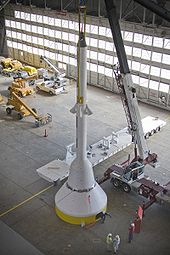
ATK 항공우주항공은 2008년 11월 20일 첫 번째 오리온 발사 중단 시스템(LAS) 시험을 성공적으로 마쳤다.LAS 모터는 발사대에 비상 상황이 발생할 경우 또는 로켓이 [102]궤도에 오르는 첫 30만 피트 (91 km) 동안 50만 파운드힘 (2,200 kN)의 추진력을 제공할 수 있다.
2009년 3월 2일, 풀사이즈의 풀웨이트 커맨드 모듈 목업(패스파인더)이 랭글리 연구 센터에서 뉴멕시코주 화이트 샌즈 미사일 레인지로 이동하여 at-gantry 발사체 조립 훈련과 LES [103]테스트를 실시했습니다.2010년 5월 10일, NASA는 화이트 샌즈 뉴 멕시코에서 LES PAD-Abort-1 실험을 성공적으로 수행하였고, 약 6,000피트 (1,800미터)의 고도까지 보일러 플레이트 (물고기) 오리온 캡슐을 발사하였다.이 테스트에서는 3개의 고체 연료 로켓 모터(주 추력 모터, 자세 제어 모터 및 분사 모터)[104]를 사용했습니다.
스플래시다운 리커버리 테스트
2009년, 프로그램의 콘스텔레이션 단계 동안, 착륙 후 오리온 회수 시험(PORT)은 승무원 구조 방법과 우주 비행사들이 착륙 후 어떤 움직임을 예상할 수 있는지를 판단하고 평가하기 위해 고안되었다.평가 과정은 장비, 선박, 승무원들의 요구를 포함한 NASA의 착륙 복구 작업 설계를 지원했다.
PORT Test는 NASA의 오리온 선원 모듈의 실물 크기의 보일러 플레이트를 사용하여 시뮬레이션된 실제 기상 조건 하에서 물속에서 테스트되었습니다.테스트는 2009년 3월 23일 해군이 제작한 18,000파운드(8,200kg)짜리 보일러 플레이트를 테스트 풀에 장착하여 시작되었습니다.2009년 4월 6일부터 30일까지 NASA의 케네디 우주 센터 앞바다에서 언론 보도와 [105]함께 전 해상 시험을 실시했습니다.
Constellation 프로그램 취소
2009년 5월 7일, 오바마 행정부는 진행 중인 NASA 우주 탐사 프로그램에 대한 완전한 독립적인 검토를 수행하도록 어거스틴 위원회에 요청했다.위원회는 당시 Constellation Program의 예산이 턱없이 부족하고, 비용이 상당히 초과되고, 몇 가지 필수 구성요소에서 예정보다 4년 이상 늦어지고, 예정된 [106][107]목표를 달성할 수 없을 것으로 보고 있습니다.그 결과, 위원회는 목표와 자원의 대폭적인 재할당을 권고했다.이러한 권장사항에 기초한 많은 결과 중 하나로, 2010년 10월 11일 Constellation 프로그램이 취소되어 Altair, Ares I 및 Ares V의 개발이 종료되었습니다.오리온 탐사선은 취소에서 살아남아 우주발사체([108]SLV)로 옮겨졌다.
오리온 다목적 승무원 차량(MPCV)
오리온 개발 프로그램은 각각 다른 [109]임무를 위해 세 가지 버전의 오리온 캡슐에서 여러 작업을 [5]수행할 수 있는 단일 버전으로 MPCV 개발로 재구성되었다.2014년 12월 5일, 개발 중인 오리온 우주선이 성공적으로 우주로 발사되었고 탐사 비행 테스트-1에서 낙하한 [110][111]후 바다에서 회수되었다.
오리온 스플래시다운 복구 테스트
2014년 12월 EFT-1에 앞서 여러 예비 차량 구난 테스트가 수행되었으며, 이는 PORT가 확립한 "크롤, 걷기, 달리기" 접근법을 계속하였다."크롤" 단계는 2013년 8월 12일부터 16일까지 고정 복구 테스트(SRT)[citation needed]를 통해 수행되었습니다.노퍽 해군기지 보호수역에서 LPD-17형 USS 알링턴을 회수선으로 [112]삼아 오리온호 선원 모듈을 회수하기 위한 하드웨어와 기술을 시연했다.
"걷기" 및 "실행" 단계는 진행 중인 복구 테스트(URT)를 사용하여 수행되었습니다.또한 LPD 17급 선박을 이용하여 URT는 2014년 초 미국 해군/NASA 팀이 탐사 비행 테스트-1(EFT-1) 오리온 선원 모듈을 회수하기 위한 준비를 위해 캘리포니아 해안에서 보다 현실적인 해상 조건에서 수행되었습니다.URT 테스트는 오리온 복구 [citation needed]시스템의 출시 전 테스트 단계를 완료했습니다.
오리온 라이트
역사
오리온 라이트는 비글로우 에어로스페이스가 록히드마틴과 공동으로 제안한 경량 승무원 캡슐의 비공식 명칭이다.그것은 록히드 마틴이 NASA를 위해 개발하고 있던 오리온 우주선을 기반으로 할 예정이었다.그것은 오리온 [113]풀 오리온의 더 가볍고, 덜 능력 있고, 더 저렴한 버전이 될 것이다.
오리온 라이트(Orion Lite)를 설계한 목적은 국제우주정거장 임무에 사용할 수 있는 오리온의 벗겨진 버전을 달과 [114]화성에 더 오래 머물도록 설계된 더 빠른 오리온보다 먼저 제공하기 위한 것이다.
비글로는 2004년에 록히드 마틴과 협력하기 시작했다.몇 년 후인 2009년,[113] 비글로는 "오리온 모형, 오리온 라이트"[115]를 개발하기로 백만 달러 계약을 맺었다.
비글로우와 록히드 마틴의 오리온 라이트 우주선 협업이 끝났다.[when?]비글로는 오리온 유산이 없는 비슷한 캡슐인 CST-100을 보잉과 함께 개발하기 시작했고, 승무원을 [citation needed]ISS로 수송하기 위해 나사의 상용 승무원 개발 프로그램에 따라 선정되었습니다.
설계.
오리온 라이트의 주요 임무는 승무원을 국제우주정거장이나 Bigelow Aerospace의 계획된 B330과 같은 민간 우주정거장으로 이송하는 것이다.오리온 라이트 외관은 오리온과 동일하지만 오리온 구성에 존재하는 심우주 기반 시설은 필요하지 않습니다.이와 같이, Orion Lite는 거주할 수 있는 더 큰 내부 부피와 지구 궤도 구성을 지원하는 [116]데 필요한 장비의 무게를 줄인 결과로 약 7명의 더 큰 승무원을 지원할 수 있을 것입니다.
회복
오리온 라이트의 무게를 줄이기 위해, 더 내구성이 높은 오리온의 방열판은 지구 저궤도에서 지구 대기권 재진입의 낮은 온도를 지원하기 위해 설계된 가벼운 방열판으로 대체될 것이다.또한, 현재의 제안은 다른 항공기가 하강하는 오리온 라이트 [citation needed]모듈을 포착하는 공중 회수를 요구한다.지금까지 이러한 회수 방법은 인공위성과 [117]함께 사용되었지만 승무원 우주선에는 사용되지 않았다.
비행편
비행 목록
| 미션 | 패치 | 시작하다 | 발사체 | 결과 | 지속 | 요약 |
|---|---|---|---|---|---|---|
| MLAS |
| MLAS | 성공. | 57초 | Max Launch Abort System(MLAS) 시험 비행 | |
| 아레스 I-X | 아레스 I-X | 성공. | 최대 6분 | 아레스 로켓 시험 비행 | ||
| 패드 Abort-1 |
| 오리온 발사 중지 시스템(LAS) | 성공. | 95초 | 오리온 발사 중지 시스템(LAS)의 비행 시험 | |
| 탐사 비행 테스트-1 |
|
| 성공. | 4시간 24분 | 오리온의 방열판, 낙하산, 투하 부품 및 탑재 [118]컴퓨터의 궤도 비행 테스트.오리온은 USS 앵커리지에 의해 회수되어 플로리다에 [119]있는 케네디 우주 센터로 귀환하기 위해 캘리포니아 샌디에이고로 보내졌다. | |
| 상승 중단-2 | 오리온 중단 테스트 부스터 | 성공. | 3분 13초 | 미국 항공우주국(NASA) 오리온 우주선의 발사 중지 시스템(LAS) 시험 | ||
| 아르테미스 1세 |  | SLS 블록 1 | 동작중 | 최대 25일 | 달 궤도 미개척 및 귀환 |
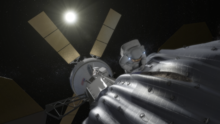
앞으로의 미션
첫 번째 승무원 비행인 아르테미스 2호는 달 [121]착륙선이 될 것이다.만약 그것이 성공한다면, 1년에 한 번 정도 비행이 계속될 것이다.
| 미션 | 패치 | 발매일 | 승무원 | 발사체 | 지속 |
|---|---|---|---|---|---|
| 아르테미스 2세 | 2024년 5월 | TBA | SLS 블록 1 승무원 | 최대 10d | |
| 아르테미스 3세 | 2025 | TBA | SLS 블록 1 승무원 | 30 d까지 | |
| 아르테미스 4세 | 2027 | TBA | SLS 블록 1B 승무원 | 30 d까지 | |
| 아르테미스 5세 | 2028 | TBA | SLS 블록 1B 승무원 | 30 d까지 |
제안.
윌리엄 H. 거스텐마이어가 2019년[122] 7월 10일 재배치 전에 큐레이팅한 제안은 2024년에서 [123][124]2028년 사이에 SLS 블록 1B에 승선한 오리온 우주선과 물류 모듈을 게이트웨이로 네 번 발사하는 것을 암시한다.승무원이 탑승한 [125]아르테미스 4호부터 7호까지는 2025년에서 2028년 사이에 매년 발사되어 부분적으로 재사용 가능한 착륙선으로 달 표면에서의 자원 이용과 원자력을 현장에서 테스트하게 된다.아르테미스 7호는 2028년에 4명의 우주 비행사를 달 표면 [125]자산으로 알려진 달 전초기지로 보낼 것이다.달 표면 자산은 미정[125] 발사대에 의해 발사될 것이며 유인 달 표면 [125][126][127][128]임무에 사용될 것이다.허블 우주 망원경의 또 다른 수리 임무도 가능하다.[129]
| 미션 | 발매일 | 승무원 | 발사체 | 지속 |
|---|---|---|---|---|
| 아르테미스 6세 | 2029년[130][131] | TBA | SLS 블록 1B 승무원 | 30 d까지 |
| 아르테미스 7세 | 2030년[130][131] | TBA | SLS 블록 1B 승무원 | 30 d까지 |
| 아르테미스 8세 | 2031년[130] | TBA | SLS 블록 1B 승무원 | 최대 60 d |
| 아르테미스 9세 | 2032 | TBA | SLS 블록 2 승무원 | 최대 60 d |
| 아르테미스 X | 2033 | TBA | SLS 블록 2 승무원 | 최대 60 d |
| 아르테미스 11세 | 2034 | TBA | SLS 블록 2 승무원 | 최대 60 d |
잠재적인 화성 탐사선
오리온 캡슐은 아마도 2030년대에 행해질 우주인들을 화성에 보내는 미래의 임무를 지원하기 위해 고안되었다.오리온 캡슐은 승무원 [132]한 명당 약 2.25m3(79cuft)의 거주 공간만을 제공하기 때문에, 장기간의 임무를 위해서는 추력을 특징으로 하는 추가 딥 스페이스 해비타트 모듈을 사용해야 할 것이다.완전한 우주선 스택은 딥 스페이스 [133]트랜스포트라고 알려져 있다.이 서식지 모듈은 우주선의 정비, 임무 통신, 운동, 훈련, 그리고 개인 [134]레크리에이션을 용이하게 할 뿐만 아니라 추가적인 공간과 보급품을 제공할 것이다.DSH 모듈에 대한 일부 개념은 DSH 모듈이 초기 개념 단계에 있지만 승무원 [134]1인당 약 703.0m(2,472 cuft)의 거주 공간을 제공한다.DSH의 크기와 구성은 승무원과 미션의 [135]필요에 따라 약간 다를 수 있습니다.이 미션은 2030년대 중반이나 2030년대 [128]후반에 발사될 것이다.
취소됨
소행성 리다이렉트 미션
소행성 회수 및 이용 임무와 소행성 이니셔티브로도 알려진 소행성 방향 수정 임무(ARM)는 2013년 나사가 제안한 우주 임무였다.소행성 회수 로봇 임무 (ARRM) 우주선은 지구에 가까운 대형 소행성과 접촉하고 고정 그립이 달린 로봇 팔을 사용하여 소행성으로부터 4미터 높이의 바위를 꺼낼 것이다.두 번째 목표는 지구에 가까운 작은 소행성을 달 궤도에 진입시키는 데 필요한 기술을 개발하는 것이었다. – "이 소행성은 보너스였다."2026년 [136]오리온 EM-5 또는 EM-6 ARCM 임무의 승무원들이 분석할 수 있다.
차량 목록
| 이미지 | 시리얼 | 상황 | 비행편 | 비행 시간 | 메모들 | 고양이. | |
|---|---|---|---|---|---|---|---|
| 은퇴한 | |||||||
| 알 수 없는 | 은퇴한 | 1 | 57년대 | 2009년 7월 Max Launch Abort System 시험발사에서 사용된 보일러 플레이트에는 서비스 모듈이 없었습니다. | |||
| 알 수 없는 | 은퇴한 | 1 | 2m, 15s | Pad Abort-1에서 사용되는 보일러 플레이트. 서비스 [137][138]모듈이 없습니다. | |||
| 001 | 은퇴한 | 1 | 4h, 24m, 46s | 탐사 비행 테스트-1에 사용된 차량.오리온 최초로 우주 비행을 했지만 서비스 모듈이 없었습니다.오리온 001은 현재 케네디 우주센터 방문자 [139][140]단지에 전시되어 있다.[141] | |||
| 확장 | |||||||
| CM/LAS | 확장 | 1 | 최대 600만 | Ares I-X 출시에 사용된 보일러 플레이트는 서비스 모듈이 없습니다. | |||
| 알 수 없는 | 확장 | 1 | 3m, 13s | Ascent Abort-2에서 사용되는 보일러 플레이트.서비스 모듈이 없습니다.비행 [142][143]중에 고의로 파괴됐어 | |||
| 활동적인 | |||||||
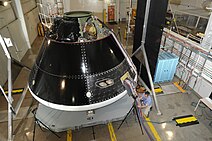 | GTA | 활동적인 | 0 | 없음. | 지상 시험 기사, 모의 서비스 [144][145]모듈을 사용한 오리온 승무원 모듈 설계의 지상 시험에 사용됩니다. | ||
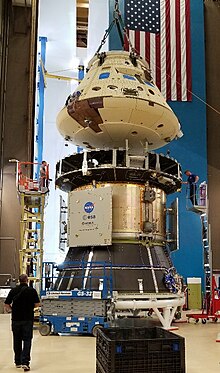 | 스타 | 활동적인 | 0 | 없음. | 구조 시험 기사,[146] 완전한 오리온 우주선 설계의 구조 시험에 사용됩니다. | ||
| 002 | 활동적인 | 1 | 1일 16시간 25분 (진행 중) | 아르테미스 [140][147]I에 사용된 차량입니다. | |||
| 공사중 | |||||||
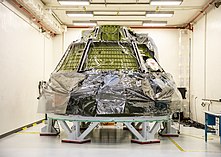 | 003 | 공사중 | 0 | 없음. | Artemis II에 사용되는 차량.처음에 오리온은 [147]승무원을 태울 계획을 세웠다. | ||
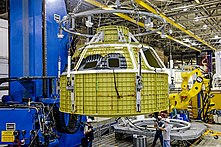 | 004 | 공사중 | 0 | 없음. | Artemis [147]III에 사용되는 차량.압력용기는 2021년 [148]8월에 미후드에서 완성되었다. | ||
| 005 | 공사중 | 0 | 없음. | Artemis [147]IV에 사용되는 차량.오리온 생산 및 운영 [148]계약에 따라 주문됩니다. | |||
| 006 | 공사중 | 0 | 없음. | Artemis [147]V에 사용되는 차량.오리온 생산 및 운영 [148]계약에 따라 주문됩니다. | |||
| 테스트 차량 우주 비행체 |
「 」를 참조해 주세요.
- 승무원 우주선 목록
- 2010년 NASA 허가법– 미국법
- 버락 오바마 행정부의 우주 정책 – 2010년 이후 NASA에 대한 미국 연방 계획
레퍼런스
![]() 이 문서에는 미국 항공우주국의 웹사이트 또는 문서에 있는 공공 도메인 자료가 포함되어 있습니다.
이 문서에는 미국 항공우주국의 웹사이트 또는 문서에 있는 공공 도메인 자료가 포함되어 있습니다.
- ^ "Preliminary Report Regarding NASA's Space Launch System and Multi-Purpose Crew Vehicle" (PDF). NASA. January 2011. Archived (PDF) from the original on February 13, 2017. Retrieved May 25, 2011.
- ^ "NASA Authorization Act of 2010". Thomas.loc.gov. Archived from the original on December 19, 2010. Retrieved November 20, 2010.
- ^ Bergin, Chris (July 10, 2012). "NASA ESD set key Orion requirement based on Lunar missions". NASASpaceFlight.com. Archived from the original on July 17, 2012. Retrieved July 23, 2012.
- ^ Moskowitz, Clara (November 2014). "Deep Space or Bust". Scientific American. 311 (6): 20. Bibcode:2014SciAm.311f..20M. doi:10.1038/scientificamerican1214-20. Archived from the original on July 29, 2017. Retrieved June 9, 2017.
- ^ a b "Orion Quick facts" (PDF). NASA. August 4, 2014. Archived (PDF) from the original on June 3, 2016. Retrieved October 29, 2015.
- ^ "NASA Commits to Long-term Artemis Missions with Orion Production Contract". NASA. NASA. September 23, 2019. Archived from the original on June 24, 2020. Retrieved April 18, 2020.
- ^ Foust, Jeff (September 24, 2019). "NASA awards long-term Orion production contract to Lockheed Martin". SpaceNews. Retrieved December 10, 2019.
The Orion Production and Operations Contract includes an initial order of three Orion spacecraft, for missions Artemis 3, 4 and 5, for $2.7 billion.
- ^ Clark, Stephen (November 29, 2019). "Earth observation, deep space exploration big winners in new ESA budget". Spaceflight Now. Archived from the original on December 10, 2019. Retrieved December 10, 2019.
ESA member states put up money for two Orion service modules at this week's summit in Seville. The power and propulsion modules will fly with NASA's Orion spacecraft carrying astronauts to the moon on the Artemis 3 and Artemis 4 missions...
- ^ Kraft, Rachel (May 16, 2022). "Artemis I Mission Availability". NASA. Retrieved September 7, 2022.
- ^ Wattles, Jackie (November 8, 2022). "NASA's Artemis I mission delayed again as storm barrels toward launch site". CNN. Warner Bros Discovery. Retrieved November 9, 2022.
- ^ a b "NASA Prepares Rocket, Spacecraft Ahead of Tropical Storm Nicole, Re-targets Launch". NASA. November 8, 2022. Retrieved November 9, 2022.
- ^ Peterson, L. (2009). "Environmental Control and Life Support System (ECLSS)" (PDF). NTRS.nasa.gov. Ames Research Center: NASA. Archived (PDF) from the original on April 7, 2014. Retrieved April 7, 2014.
- ^ a b c "NASA Goes 'Green': Next Spacecraft to be Reusable – Orion Capsule". Space.com. June 13, 2013. Archived from the original on December 4, 2014. Retrieved November 30, 2014.
- ^ "NASA – A 21st Century-Style Return to the Moon". nasa.gov. Archived from the original on September 5, 2017. Retrieved June 3, 2018.
- ^ Bergin, Chris (October 30, 2014). "EFT-1 Orion completes assembly and conducts FRR". NASASpaceflight.com. Archived from the original on August 17, 2016. Retrieved November 10, 2014.
- ^ "NASA – Orion Crew Exploration Vehicle" (PDF) (Press release). NASA. February 7, 2009. Archived (PDF) from the original on April 8, 2021. Retrieved February 7, 2009.
- ^ "Lockheed to build Nasa 'Moonship'". BBC News. August 31, 2006. Archived from the original on April 17, 2021. Retrieved March 1, 2007.
- ^ a b LaNasa, Shannon (2021). "Michoud Tenants: Lockheed Martin". Marshall Space Flight Center. NASA. Archived from the original on March 18, 2021. Retrieved June 27, 2021.
 이 문서에는 퍼블릭 도메인에 있는 이 소스로부터의 텍스트가 포함되어 있습니다.
이 문서에는 퍼블릭 도메인에 있는 이 소스로부터의 텍스트가 포함되어 있습니다. - ^ a b Cristina, Victoria (April 26, 2021). "Behind the scenes at NASA Michoud: Assembly of the Orion Crew Modules". WGNO. Nexstar Media Group. Retrieved February 12, 2022.
- ^ NASA Orion public relations [@NASA_Orion] (September 10, 2021). "Technicians at NASA's Michoud Assembly Facility completed the welding on Orion's pressure vessel which will carry @NASA_Astronauts to the Moon on #Artemis III" (Tweet) – via Twitter.
- ^ "NASA Names New Crew Exploration Vehicle Orion" (Press release). NASA. August 22, 2006. Archived from the original on April 8, 2021. Retrieved March 3, 2007.
- ^ "NASA Selects Material for Orion Spacecraft Heat Shield" (Press release). NASA Ames Research Center. April 7, 2009. Archived from the original on March 17, 2021. Retrieved April 16, 2009.
- ^ Coppinger, Rob (October 6, 2006). "NASA Orion crew vehicle will use voice controls in Boeing 787-style Honeywell smart cockpit". Flight International. Archived from the original on January 5, 2018. Retrieved October 6, 2006.
- ^ a b "Orion landings to be splashdowns – KSC buildings to be demolished". NASA SpaceFlight.com. August 5, 2007. Archived from the original on June 7, 2016. Retrieved August 5, 2007.
- ^ "NASA Denies Making Orion Water Landing Decision – and Deleting Touchdowns on Land". NASA Watch. August 6, 2007. Retrieved November 23, 2010.
- ^ "NASA Announces Key Decision For Next Deep Space Transportation System". NASA. May 24, 2011. Archived from the original on September 15, 2016. Retrieved May 25, 2011.
- ^ Hill, Denise (July 23, 2019). "S.A.M. Goes to Work Aboard ISS". NASA. Archived from the original on November 7, 2020. Retrieved July 31, 2019.
- ^ "US and Europe plan new spaceship". BBC News. May 5, 2011. Archived from the original on May 6, 2011. Retrieved May 14, 2011.
- ^ "ATV evolution studies look at exploration, debris removal". Spaceflight Now. June 21, 2012. Archived from the original on February 6, 2013. Retrieved June 23, 2012.
- ^ "Airbus Defence and Space awarded two ATV evolution studies from ESA". Astrium. June 21, 2012. Archived from the original on April 3, 2013. Retrieved June 23, 2012.
- ^ Bergin, Chris (November 21, 2012). "UK steps up, as ESA commit to ATV Service Module on NASA's Orion". NASASpaceFlight.com. Archived from the original on December 5, 2012. Retrieved July 15, 2014.
- ^ a b "Multi Purpose Crew Vehicle – European Service Module for NASA's Orion programme". Airbus Defence and Space. Archived from the original on March 6, 2016. Retrieved March 7, 2016.
- ^ a b "NASA Signs Agreement for a European-Provided Orion Service Module". nasa.gov. January 16, 2013. Archived from the original on March 28, 2014. Retrieved March 28, 2014.
- ^ Cody Zoller (December 1, 2015). "NASA to begin testing Orion's European Service Module". NASA SpaceFlight. Archived from the original on March 6, 2016. Retrieved March 7, 2016.
- ^ Airbus Defense and Space는 웨이백 머신에서 2017년 4월 19일 보관된 NASA의 오리온 유인 우주 캡슐의 두 번째 서비스 모듈에 대한 2억 유로 ESA 계약을 따냈습니다.에어버스 디펜스 앤 스페이스 보도 자료입니다2017년 2월 16일
- ^ a b "Call for media: The European Service module meets Orion". European Space Agency. October 26, 2018. Archived from the original on February 6, 2020. Retrieved February 6, 2020.
- ^ "Mission to the Moon: How We'll Go Back – and Stay This Time". popularmechanics.com. Archived from the original on February 3, 2008. Retrieved February 8, 2008.
- ^ Mika McKinnon (December 4, 2014). "Meet Orion, NASA's New Deep Space Explorer". Space.io9.com. Archived from the original on November 8, 2015. Retrieved October 31, 2016.
- ^ "Launch Abort System Jettison Motor Aerojet Rocketdyne". Rocket.com. Archived from the original on January 25, 2016. Retrieved October 31, 2016.
- ^ "ATK Awarded Contract for Orion Launch Abort Motors". PRNewswire. Archived from the original on March 1, 2012.
- ^ "Orion's New Launch Abort Motor Test Stand Ready for Action". NASA. Archived from the original on June 4, 2011. Retrieved January 5, 2012.
- ^ Rhian, Jason (July 17, 2018). "Jettison Motor Readied For Integration Into Orion's LAS". spaceflightinsider.com. Spaceflight Insider. Archived from the original on July 1, 2019. Retrieved July 1, 2019.
The jettison motor separates the LAS from the Orion capsule on its way to orbit.
- ^ Wall, Mike (May 24, 2011). "NASA Unveils New Spaceship for Deep Space Exploration". Space.com. Archived from the original on May 25, 2011. Retrieved May 24, 2011.
- ^ Moen, Marina M. (August 8, 2011). "Feasibility of Orion Crew Module Entry on Half of Available Propellant Due to Tank Isolation Fault". American Institute of Aeronautics and Astronautics. NASA Langley Research Center. hdl:2060/20110014641.
- ^ "NASA Selects Lockheed Martin To Be Orion Crew Exploration Vehicle Prime Contractor" (Press release). NASA. August 31, 2006. Retrieved August 31, 2006.
- ^ "ESA workhorse to power NASA's Orion spacecraft / Research / Human Spaceflight / Our Activities / ESA". Esa.int. January 16, 2013. Archived from the original on November 13, 2015. Retrieved July 15, 2014.
- ^ Bergin, Chris (March 15, 2014). "EFT-1 Orion slips to December – Allows military satellite to launch first". nasaspaceflight.com. NASAspaceflight.com. Archived from the original on March 28, 2014. Retrieved March 28, 2014.
- ^ Clark, Stephen (March 15, 2014). "Launch schedule shakeup delays Orion to December". spaceflightnow.com. Archived from the original on March 28, 2014. Retrieved March 28, 2014.
- ^ "Orion Exploration Flight Test-1". aerospaceguide.net. January 11, 2014. Archived from the original on March 28, 2014. Retrieved March 28, 2014.
- ^ Fountain, Henry (December 5, 2014). "NASA's Orion Spacecraft Splashes Down in Pacific After Test Flight". New York Times. Archived from the original on April 12, 2019. Retrieved December 5, 2014.
- ^ Grush, Loren (November 30, 2020). "Component failure in NASA's deep-space crew capsule could take months to fix". The Verge. Archived from the original on December 4, 2020. Retrieved December 3, 2020.
- ^ Klotz, Irene (December 7, 2020). "Issue with Orion power distribution unit "We really don't think it's going to be a big impact on the final schedule for the Artemis I flight," @NASA's Ken Bowersox tells reporters". Archived from the original on December 7, 2020. Retrieved December 9, 2020.
- ^ a b "NASA FY22 인플레이션 표 - FY23에서 활용 예정"(Excel). NASA입니다 2022년 10월 31일 회수했습니다이 문서에는 퍼블릭 도메인에 있는 이 소스로부터의 텍스트가 포함되어 있습니다.
- ^ "NASA's FY 2023 Budget". The Planetary Society. Retrieved November 14, 2022.
- ^ "FY 2008 Budget Estimates" (PDF). National Aeronautics and Space Administration. p. ESMD-25. Archived (PDF) from the original on June 3, 2016. Retrieved June 7, 2016.
- ^ "Fiscal Year 2009 Budget Estimates" (PDF). National Aeronautics and space Administration. p. iv. Archived (PDF) from the original on March 15, 2019. Retrieved June 7, 2016.
- ^ a b c "Fiscal Year 2010 Budget Estimates" (PDF). National Aeronautics and Space Administration. p. v. Archived (PDF) from the original on August 6, 2016. Retrieved June 7, 2016.
- ^ "FY 2013 President's Budget Request Summary" (PDF). National Aeronautics and Space Administration. p. BUD-4. Archived (PDF) from the original on December 28, 2016. Retrieved June 7, 2016.
- ^ "FY 2014 President's Budget Request Summary" (PDF). National Aeronautics and Space Administration. p. BUD-8. Archived (PDF) from the original on February 17, 2017. Retrieved June 7, 2016.
- ^ "FY 2015 President's Budget Request Summary" (PDF). National Aeronautics and Space Administration. p. BUD-5. Archived (PDF) from the original on February 15, 2017. Retrieved June 7, 2016.
- ^ "FY 2016 President's Budget Request Summary" (PDF). National Aeronautics and space Administration. p. BUD-5. Archived (PDF) from the original on April 14, 2016. Retrieved June 7, 2016.
- ^ "FY 2017 Budget Estimates" (PDF). nasa.gov. National Aeronautics and Space Administration. p. BUD-4. Archived (PDF) from the original on November 7, 2017. Retrieved January 1, 2019.
- ^ "FY 2018 Budget Estimates" (PDF). nasa.gov. National Aeronautics and Space Administration. p. BUD-3. Archived (PDF) from the original on November 5, 2017. Retrieved January 1, 2019.
- ^ "Public Law 115-31, 115th Congress" (PDF). congress.gov. p. 213. Archived (PDF) from the original on December 22, 2018. Retrieved January 1, 2019.
- ^ "2018 Consolidated Appropriations Act" (PDF). congress.gov. p. 82. Archived (PDF) from the original on December 23, 2018. Retrieved January 1, 2019.
- ^ "FY 2021 President's Budget Request Summary" (PDF). National Aeronautics and Space Administration. p. DEXP-4. Archived (PDF) from the original on June 17, 2020. Retrieved May 10, 2020.
- ^ "H.R.1158 – 116th Congress (2019–2020): Consolidated Appropriations Act, 2020". www.congress.gov. December 20, 2019. p. 250. Archived from the original on January 10, 2020. Retrieved January 9, 2020.
- ^ '미국항공우주국 2021년도 지출계획'(PDF). NASA. 원래 2022년 10월 31일에 보관되어 있습니다. 2022년 10월 31일 취득 이 문서에는 퍼블릭 도메인에 있는 이 소스로부터의 텍스트가 포함되어 있습니다.
- ^ 「통합 세출법, 2022」(PDF). 2022년 10월 31일 회수. 페이지 2122022년 10월 31일 원본에서 보관.이 문서에는 퍼블릭 도메인에 있는 이 소스로부터의 텍스트가 포함되어 있습니다.
- ^ "NASA Actions Needed to Improve Transparency and Assess Long Term Affordability of Human Exploration Programs" (PDF). General Accounting Office. May 2014. p. 2. Archived (PDF) from the original on March 10, 2016. Retrieved June 7, 2016.
- ^ "NASA Commits to Long-term Artemis Missions with Orion Production Contract". NASA.gov. Archived from the original on July 21, 2020. Retrieved July 26, 2020.
- ^ Smith, Marcia (January 17, 2013). "NASA-ESA Agreement on Orion Service Module is For Only One Unit Plus Spares". spacepolicyonline.com. Archived from the original on August 12, 2016. Retrieved June 28, 2016.
- ^ Clark, Stephen (December 3, 2014). "ESA member states commit funding for Orion service module". spaceflightnow.com. Archived from the original on December 5, 2014. Retrieved June 28, 2016.
- ^ "NASA's Ground Systems Development and Operations Program Completes Preliminary Design Review". National Aeronautics and Space Administration. Archived from the original on September 30, 2021. Retrieved June 28, 2016.
- ^ "FY 2016 President's Budget Request Summary" (PDF). National Aeronautics and Space Administration. p. BUD-5. Archived (PDF) from the original on April 14, 2016. Retrieved June 28, 2016.
- ^ "NASA FY 2021 Budget Estimates" (PDF). NASA.gov. Archived (PDF) from the original on July 27, 2020. Retrieved July 26, 2020.
- ^ J. Foust (September 16, 2015). "First Crewed Orion Mission May Slip to 2023". Space News. Archived from the original on September 23, 2015. Retrieved September 16, 2015.
- ^ Clark, Stephen (September 16, 2015). "Orion spacecraft may not fly with astronauts until 2023". spaceflightnow.com. Archived from the original on July 1, 2016. Retrieved June 7, 2016.
- ^ Smith, Marcia (May 1, 2014). "Mikulski "Deeply Troubled" by NASA's Budget Request; SLS Won't Use 70 Percent JCL". spacepolicyonline.com. Archived from the original on August 5, 2016. Retrieved June 7, 2016.
- ^ "Orion Production and Operations Contract". govtribe.com. Archived from the original on July 26, 2020. Retrieved July 26, 2020.
- ^ Berger, Eric (September 24, 2019). "After 15 years of development, Lockheed wins new cost-plus contract for Orion; Originally, NASA had hoped for a fixed-price deal". ars.technica. Archived from the original on July 16, 2020. Retrieved July 26, 2020.
- ^ Berger, Eric (August 19, 2016). "How much will SLS and Orion cost to fly? Finally, some answers". arstechnica.com. Archived from the original on December 24, 2018. Retrieved January 1, 2019.
- ^ Berger, Eric (October 20, 2017). "NASA chooses not to tell Congress how much deep space missions cost". arstechnica.com. Archived from the original on December 17, 2018. Retrieved January 1, 2019.
- ^ "NASA Extreme Makeover—Space Vehicle Mockup Facility". nasa.gov. Archived from the original on June 29, 2015. Retrieved December 5, 2014.
- ^ "What Goes Up Must Come Down As Orion Crew Vehicle Development Continues". Space-travel.com. Archived from the original on January 6, 2012. Retrieved July 15, 2014.
- ^ "Orion Continues to Make a Splash". Space-travel.com. Archived from the original on January 10, 2012. Retrieved July 15, 2014.
- ^ "Orion Drop Test – Jan. 06, 2012". Space-travel.com. Archived from the original on January 13, 2012. Retrieved July 15, 2014.
- ^ Bergin, Chris (November 6, 2011). "NASA managers approve EFT-1 flight as Orion pushes for orbital debut". NASASpaceFlight.com. Archived from the original on January 11, 2012. Retrieved July 15, 2014.
- ^ a b Bergin, Chris (October 17, 2011). "Space-bound Orion taking shape – "Lunar Surface First" missions referenced". NASASpaceFlight.com. Archived from the original on December 26, 2011. Retrieved July 15, 2014.
- ^ "NASA Conducts Orion Parachute Testing for Orbital Test Flight". Space-travel.com. Archived from the original on January 10, 2012. Retrieved July 15, 2014.
- ^ Bergin, Chris (February 10, 2012). "Orion hoping for success with second generation parachute system". NASASpaceFlight.com. Archived from the original on February 13, 2012. Retrieved July 15, 2014.
- ^ Bergin, Chris (February 26, 2012). "Orion PTV preparing for drop test on Wednesday – EFT-1 Orion progress". NASASpaceFlight.com. Archived from the original on February 28, 2012. Retrieved July 15, 2014.
- ^ "NASA Conducts New Parachute Test for Orion". Space-travel.com. Archived from the original on March 4, 2012. Retrieved July 15, 2014.
- ^ "Orion parachutes preparing for another milestone drop test on April 17 NASASpaceFlight.com". www.nasaspaceflight.com. April 12, 2012. Archived from the original on April 14, 2012. Retrieved August 26, 2015.
- ^ "President Bush Announces New Vision for Space Exploration Program" (Press release). White House Office of the Press Secretary. January 14, 2004. Archived from the original on May 21, 2011. Retrieved September 1, 2006.
- ^ "Orion Spacecraft – Nasa Orion Spacecraft". aerospaceguide.net. Archived from the original on August 6, 2016. Retrieved February 2, 2013.
- ^ "NASA Names New Crew Exploration Vehicle Orion" (Press release). NASA. August 22, 2006. Archived from the original on January 27, 2012. Retrieved April 17, 2010.
- ^ Handlin, Daniel; Bergin, Chris (October 11, 2006). "NASA sets Orion 13 for Moon Return". NASAspaceflight.com. Archived from the original on April 17, 2021. Retrieved March 3, 2007.
- ^ Handlin, Daniel; Bergin, Chris (July 22, 2006). "NASA makes major design changes to CEV". NASAspaceflight.com. Archived from the original on April 17, 2021. Retrieved March 3, 2007.
- ^ "NASA Names Orion Contractor". NASA. August 31, 2006. Archived from the original on November 20, 2011. Retrieved September 5, 2006.
- ^ "NASA Glenn To Test Orion Crew Exploration Vehicle". SpaceDaily. Archived from the original on February 10, 2012. Retrieved January 5, 2012.
- ^ "NASA: Constellation Abort Test November 2008". Nasa.gov. December 11, 2008. Archived from the original on April 8, 2021. Retrieved November 20, 2010.
- ^ "NASA Orion LAS Pathfinder". Nasa.gov. Archived from the original on April 8, 2021. Retrieved November 20, 2010.
- ^ "NASA Completes Test of Orion Crew Capsule". foxnews.com. May 6, 2010. Archived from the original on January 23, 2014. Retrieved April 6, 2013.
- ^ "NASA Orion PORT Test". Nasa.gov. March 25, 2009. Archived from the original on November 24, 2010. Retrieved November 20, 2010.
- ^ 어거스틴 위원회 최종 보고서 2009년 11월 22일 Wayback Machine에서 2009년 10월 22일 발행.2014년 12월 14일 회수
- ^ NASA in Obama's Hands Archived 2015년 12월 22일, 나다니엘 다운스가 Wayback Machine Information Addict 웹사이트에서 보관.2012년 6월 18일 발행.2014년 12월 14일 취득
- ^ "Today – President Signs NASA 2010 Authorization Act". Universetoday.com. Archived from the original on February 5, 2021. Retrieved November 20, 2010.
- ^ NASA의 Constellation Program은 무엇입니까?원본 Sciences 360 웹 사이트인 By Tenebris에서 아카이브되었습니다.오리온 캡슐의 복수 버전 개발 논의.2009년 11월 17일 발행.2014년 7월 5일 취득
- ^ "Orion Spacecraft Complete". NASA. October 30, 2014. Archived from the original on October 31, 2014. Retrieved October 30, 2014.
- ^ Fountain, Henry (December 5, 2014). "NASA's Orion Spacecraft Splashes Down in Pacific After Test Flight". The New York Times. Archived from the original on December 13, 2014. Retrieved December 5, 2014.
- ^ "NASA & US Navy Test Demonstrates Water Recovery of Orion Crew Capsule". Universetoday.com. August 16, 2013. Archived from the original on October 4, 2013. Retrieved July 15, 2014.
- ^ a b Klamper, Amy (August 14, 2009). "Nevada Company Pitches 'Lite' Concept for NASA's New Spaceship". space.com. Archived from the original on November 9, 2020. Retrieved October 17, 2020.
- ^ Klamper, Amy (August 14, 2009). "Company pitches 'lite' spaceship to NASA". NBC News. Archived from the original on February 12, 2020. Retrieved September 7, 2009.
- ^ Bigelow는 2012년 7월 7일 Wayback Machine, The Space Review, 2010-11-01에서 2010-11-02에 액세스한 대규모 아카이브를 여전히 고려하고 있습니다.[2010년 10월] 비글로우는 2004-2005년 동안 록히드 마틴과 캡슐 컨셉을 함께 해왔다고 밝혔다.'우리는 록히드와 몇 년 후 백만 달러 계약을 했고 그들은 우리에게 오리온 라이트라는 오리온 모형을 만들어 주었다.'
- ^ 스페이스 호텔 비전, NASA에 개량된 '오리온 라이트' 우주선 제안: 비글로우 에어페이스의 컨셉은 지구 저궤도 미션용. 2020년 6월 11일, 웨이백 머신, 파퓰러 사이언스, 제레미 Hsu, 2009년 8월 14일 아카이브 완료
- ^ "Discoverer 14 – NSSDC ID: 1960-010A". NASA. Archived from the original on June 11, 2020. Retrieved February 8, 2020.
- ^ "NASA's New Orion Spacecraft Completes First Spaceflight Test". NASA.gov. Archived from the original on November 12, 2020. Retrieved December 9, 2014.
- ^ "Orion Off-loaded for Trip Back to Florida". NASA.gov. Archived from the original on March 23, 2015. Retrieved December 9, 2014.
- ^ Artemis I Launch to the Moon (Official NASA Broadcast) - Nov. 16, 2022, retrieved November 16, 2022
- ^ Clark, Stephen (April 26, 2022). "NASA's moon rocket rolls back to Vehicle Assembly Building for repairs". Spaceflight Now. Retrieved April 26, 2022.
- ^ Davenport, Christion (July 10, 2019). "Shakeup at NASA as space agency scrambles to meet Trump moon mandate". Washington Post. Archived from the original on July 11, 2019. Retrieved July 10, 2019.
- ^ Berger 2019, "이 기관의 선임 우주 비행 관리자인 Bill Gerstenmaier에 의해 개발된 이 계획은 펜스가 요청한 모든 것, 즉 긴급한 인간 귀환, 달 기지, 기존 계약자와 신규 계약자의 혼합입니다."
- ^ Foust 2019, "Artemis 3 이후, NASA는 2025년에서 2028년 사이에 달 표면에 4개의 추가 유인 미션을 발사할 것이다.한편, 이 기관은 추가 부품과 승무원 차량을 출시하고 궁극적인 달 기지의 기반을 마련함으로써 게이트웨이를 확장하기 위해 노력할 것입니다."
- ^ a b c d "America to the Moon 2024" (PDF). Archived (PDF) from the original on July 26, 2020. Retrieved December 20, 2019.
- ^ Berger 2019, "로봇과 인간 착륙선이 혼합된 것뿐만 아니라 민간 로켓과 NASA 로켓의 37회 발사를 수반하는 이 10년 계획은 2028년에 "달 표면 자산 배치"로 정점을 이루는데, 이는 장기 체류 승무원들을 위한 표면 전초기지의 시작일 것이다."
- ^ Berger 2019, [Illustation] "2024년까지 인간 달 귀환, 2028년까지 전초기지 계획"
- ^ a b Foust, Jeff (April 18, 2021). "Independent report concludes 2033 human Mars mission is not feasible". SpaceNews. Retrieved November 9, 2021.
- ^ Foust, Jeff (June 15, 2020). "Hugging Hubble longer". The Space Review. Archived from the original on June 16, 2020. Retrieved June 16, 2020.
- ^ a b c Foust, Jeff [@jeff_foust] (October 31, 2022). "The current Artemis planning manifest, now updated to include a lunar landing on Artemis 4" (Tweet). Retrieved October 31, 2022 – via Twitter.
- ^ a b "NASA Exploration Production and Operations Long-Term Sustainability Request for Information (RFI)". GovTribe. October 25, 2021. p. 5. Retrieved November 9, 2021.
- ^ "Preliminary Report Regarding NASA's Space Launch System and Multi-Purpose Crew Vehicle" (PDF). NASA. January 2011. Archived (PDF) from the original on February 13, 2017. Retrieved June 18, 2011.
- ^ NASA, 2020년 11월 11일 웨이백 머신에서 우주인들을 화성과 그 너머로 보내는 열쇠 공개.닐 V. 파텔, 더 인버스2017년 4월 4일
- ^ a b Habitat for Long Duration Deep Space Missions 2015년 9월 20일 Rucker & Thompson의 DSH용 웨이백 머신 예비 설계 제안서 아카이브.2012년 5월 5일 발행, 2014년 12월 8일 회수
- ^ 2012 X-Hab Academic Innovation Challenge Progress Update 2015년 3월 20일 Wayback Machine Nasa DSH 디자인 뉴스 업데이트에서 보관되었습니다.2012년 6월 21일 발행, 2014년 12월 8일 회수
- ^ Jeff Foust (June 14, 2017). "NASA closing out Asteroid Redirect Mission". Space News. Archived from the original on June 15, 2017. Retrieved September 9, 2017.
- ^ Dryden Flight Research Center (May 6, 2010). "Orion Pad Abort 1 Test a Spectacular Success". National Aeronautics and Space Administration (NASA). Archived from the original on March 10, 2020. Retrieved March 10, 2020.
The 500,000-lb. thrust abort motor rocketed the boilerplate crew module and its launch abort stack away from launch pad 32E at White Sands...
- ^ Pearlman, Robert (May 7, 2010). "NASA's Launch Abort Test Builds on 50 Years of Astronaut Escape Systems". Space.com. Archived from the original on March 10, 2020. Retrieved March 10, 2020.
The Pad Abort-1 (PA1) flight test, which flew a boilerplate 16-foot (4.9-meter) wide, 18,000-pound (8,160-kg) Orion capsule under a nearly 45-foot (13.7-meter)long launch abort system (LAS) tower [...] The flight lasted about 135 seconds from launch until the module touched down...
- ^ Dunn, Marcia (December 6, 2014). "NASA launches new Orion spacecraft and new era (w/ video)". Tampa Bay Times. Archived from the original on March 10, 2020. Retrieved March 10, 2020.
Friday's Orion — serial number 001 — lacked seats, cockpit displays and life-support equipment, but brought along bundles of toys and memorabilia...
- ^ a b Davis, Jason (December 5, 2014). "Orion Returns to Earth after Successful Test Flight". The Planetary Society. Archived from the original on March 10, 2020. Retrieved March 10, 2020.
As impressive as this flight was, this was just serial number 001 of Orion," he said. "Serial number 002—that one is going to be on the Space Launch System.
- ^ "Orion EFT-1 flown spacecraft joins display in 'NASA Now' exhibit collectSPACE". collectSPACE.com. Retrieved September 21, 2020.
- ^ Clark, Stephen (July 1, 2019). "Critical abort test of NASA's Orion crew capsule set for Tuesday". Spaceflight Now. Archived from the original on March 10, 2020. Retrieved March 10, 2020.
"So 20 seconds after the LAS (launch abort system) jettisons from the crew module, we start ejecting, so the first pair comes out 20 seconds after the LAS is jettisoned, and then every 10 seconds until all 12 are ejected." The capsule is expected to tumble after the abort system jettisons, and it will impact the sea at 300 mph (480 kilometers per hour) around 7 miles (11 kilometers) offshore, and is designed to sink to the ocean floor, according to Reed.
- ^ Sloss, Philip (October 25, 2019). "NASA conducting data deep dive following July's Orion ascent abort test". NASASpaceFlight.com. Archived from the original on March 10, 2020. Retrieved March 10, 2020.
The Ascent Abort-2 test used a ballistic missile to accelerate a production-design LAS with a Crew Module shaped, highly-instrumented test lab to carefully picked flight condition where a full LAS abort sequence was executed. [...] impact with the water destroyed the test article.
- ^ Kremer, Ken (March 30, 2010). "3 Welds to Go for 1st Orion Pathfinder Vehicle". Universe Today. Archived from the original on March 10, 2020. Retrieved March 10, 2020.
...the very first pathfinder Orion manned capsule – the Crew Module – known as the Ground Test Article (GTA) [...] The GTA is the first full-sized, flight-like test article for Orion.
- ^ Bergin, Chris (November 14, 2011). "EFT-1 Orion receives hatch door – Denver Orion ready for Modal Testing". NASASpaceFlight.com. Archived from the original on March 10, 2020. Retrieved March 10, 2020.
As much as the Service Module (SM) design is still undergoing evaluation – which includes discussions about utilizing hardware from the European Space Agency's ATV (Automated Transfer Vehicle) – the test vehicle includes an Orion Ground Test Article (GTA), in a Launch Abort Vehicle (LAV) configuration, with installed ogives and a mock SM.
- ^ Crane, Aimee (June 25, 2020). "Orion's 'Twin' Completes Structural Testing for Artemis I Mission". NASA. Retrieved November 16, 2022.
- ^ a b c d e Vuong, Zen (December 3, 2014). "JPL joins NASA's first agency-wide social media event to highlight Thursday's Orion flight test". Pasadena Star-News. Archived from the original on March 10, 2020. Retrieved March 10, 2020.
Orion 002, 003 and 004 will become lessons that will further humanity in its quest to inhabit Mars and become Earth-independent. [...] "Orion tail number 003 has a special place in my heart," he said. "Four of my astronauts are going to climb into it and have an adventure of a lifetime...
- ^ a b c Damadeo, Kristyn (September 9, 2021). "Next Generation of Orion Spacecraft in Production". NASA. Archived from the original on September 23, 2021. Retrieved October 6, 2021.
외부 링크
